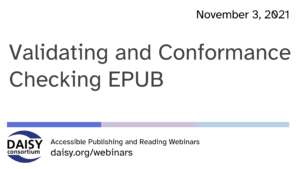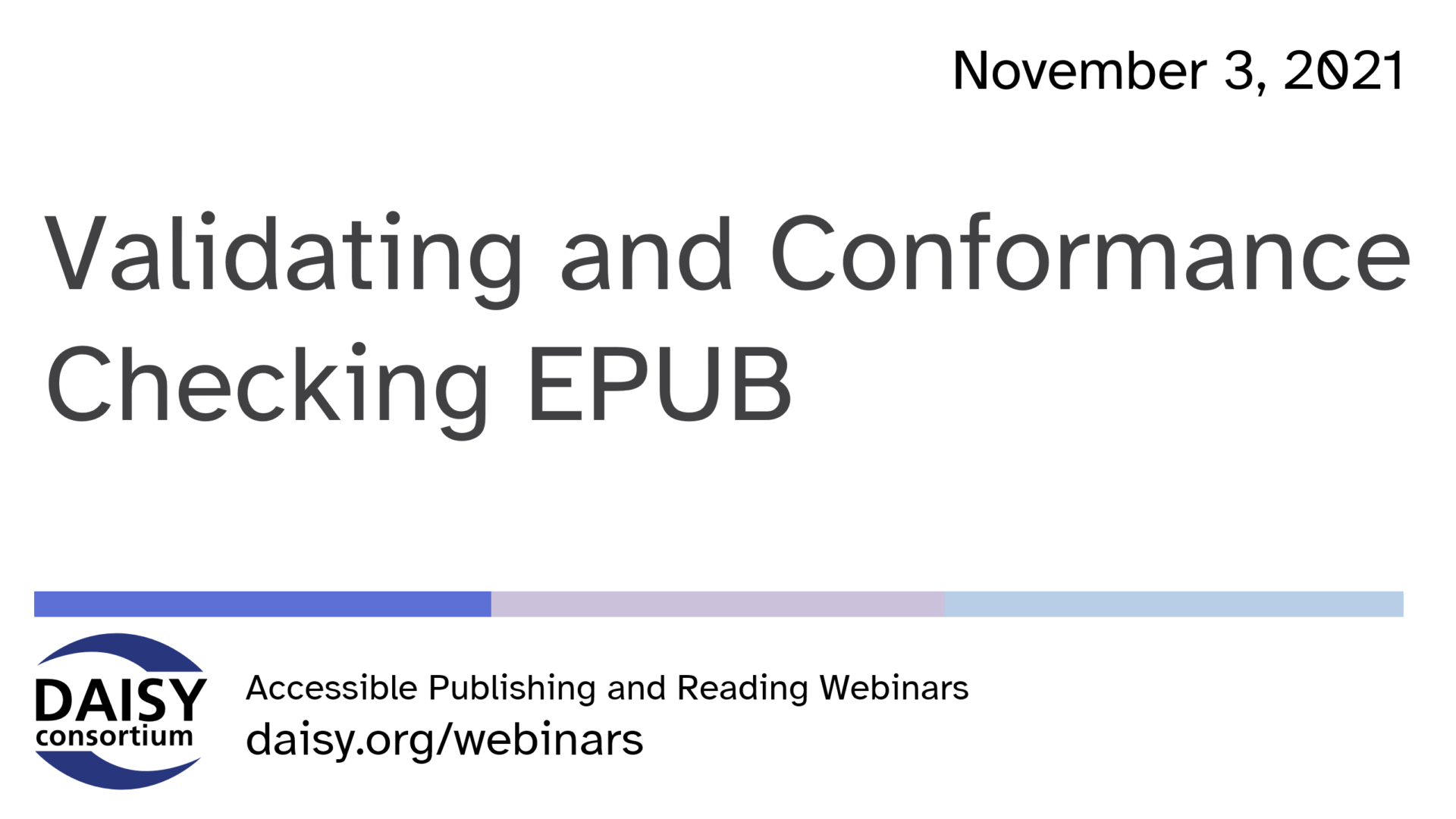Validating and Conformance Checking of EPUB (W)
 In our series of free weekly webinars November 3rd saw a session focused on the validation and conformance of EPUB content. When using the EPUB format a few simple steps can help highlight any issues and guide you on the path to creating more usable and accessible content.
In our series of free weekly webinars November 3rd saw a session focused on the validation and conformance of EPUB content. When using the EPUB format a few simple steps can help highlight any issues and guide you on the path to creating more usable and accessible content.
This page contains:
Full Video of the Webinar
Speakers
- Richard Orme, DAISY Consortium—host and chair
- George Kerscher, DAISY Consortium
- James Yanchak, Taylor and Francis
- Charles La Pierre, Benetech
Session Overview
Richard Orme introduced this session explaining that it’s not enough to create content in any format and simply hope it works on reading systems and that it can deliver accessibility. The three experts presenting this webinar looked at validating EPUB from their perspective angles.
What Is An Accessible EPUB?
Many publishers have switched to EPUB as their format of choice for their digital content workflow but, despite it being the format which offers the greatest opportunity for accessibility, some have missed the mark. By failing to include a table of contents, for example, or by not having a clear reading order, EPUB content was often disappointingly lacking in accessibility support. For an EPUB file to be accessible, the publisher must make the most of the features that the format offers.
An understanding of this together with knowledge of the legal requirements in your market are a good place to start an accessibility journey. Add to this an alignment with publishing and web standards and some technical research to provide a base of knowledge and publishers should be in a position to make the most of their EPUB workflow.
3rd Party Certification
Having a 3rd party certify your accessible content helps the publisher to navigate the standards and specifications and Charles La Pierre talked us through the Benetech Scheme, Global Certified Accessible (GCA), outlining the process required for a publisher to be certified. A score is attached and for content to be certified as Born Accessible, 80% is needed.
Developing Internal Standards
Internal standards help the publisher to narrow the technical landscape and make it relevant to their specific workflow. James Yanchak described how this is achieved at Taylor and Francis and explained how this has helped them to reach their accessibility goals. Any internal standard must adhere to the industry standard and it’s vital that training is offered to both in-house colleagues and external vendors.
Validating the EPUB
There are a number of tools which our panel recommended:
- EPUBCheck – should be one of the first checks and if this is integrated into the workflow using the command line version then it becomes very straightforward.
- Ace by DAISY – checks conformance of the EPUB to WCAG and offers a command-line version and a desktop version for one-off title checks
- Ace SMART – to be used in conjunction with Ace and helps the user perform the manual checks that Ace identifies.
- The DAISY Knowledge Base has been developed to help resolve accessibility issues and is constantly maintained.
All of these stages and checks are important to establish accessibility and “trust” in the end product. A reader needs to be able to trust the accessibility summary and metadata so that they can make the correct purchasing decisions.
Related Resources
Standards
- Web Content Accessibility Guidelines (WCAG) 2.0
- Accessible Rich Internet Applications (WAI-ARIA) 1.1
- EPUB Accessibility 1.0 – Conformance and Discovery
- Digital Publishing WAI-ARIA Module 1.0
- EPUB 3.3
- HTML
- Scalable Vector Graphics (SVG) 2
- Mathematical Markup Language (MathML) Version 3.0 2nd Edition

